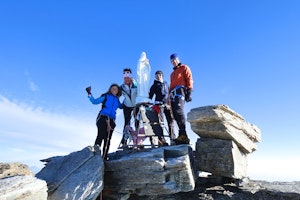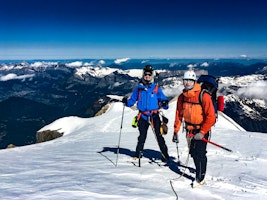For a long time, off-piste skiing was reserved for experienced skiers and snowboarders. Today, this activity has more and more followers due to the evolution of equipment and amazing videos posted by professionals.
But the mountain is full of dangers, often imperceptible. It is important to be aware that we practice this sport in untouched nature, by definition uncontrolled, and often in remote areas, far from the slopes. It is necessary to take note of the phone numbers of local emergency services, who know the area best and will be faster at the scene in the case of an accident. You should also identify well the location where your freeride day will take place: name of the town —the name of the itinerary or any specific spot— and, even better, the GPS coordinates of the area where you will ski. You can have these with most smartphones (or specific apps). This useful information will be essential for rescue teams in case there is an accident, in order to have a fast intervention.
 Photo: Sebastien Laurent
Photo: Sebastien Laurent
When talking about avalanches, crevasses, ice slabs or rock bars, security becomes a necessary component of freeride. One of the most reliable ways to protect yourself is to hire a mountain guide.
Each time you go freeride skiing, it is important to learn about the spot, the snow and the avalanche risk from local emergency services and professionals and, of course, to be properly equipped for the backcountry.
The basic equipment for freeriding:
Avalanche transceiver, shovel and probe are commonly accepted as the basic triptych of any freerider. You should know that, after being buried for more than 15 minutes, chances of survival decrease dramatically. This basic equipment is crucial.
The avalanche transceiver
The principle is simple: worn under clothing, the avalanche transceiver must always be on and in transmitter-mode. The buried skier can thus be located by another, who will switch his equipment to receiver-mode. Whatever the brand or model, all avalanche transceivers communicate with each other via signals on the 457kHz frequency. While they might be easy to use, some previous practice is necessary as the panic of an accident makes them more difficult to manage.
 Avalanche Transceiver
Avalanche Transceiver
The probe
When the shortest distance with the transceiver has been reached, the sounding begins. The sensor must always be planted perpendicular to the surface of the snow. Once the victim is localized, the probe will become a valuable reference point.
It is preferable for the probe to be thick and rigid, so that it doesn’t deviate through the snow layers. This also favors an easy tensioning and locking system because, with the stress and cold, forces will be reduced.
 The probe
The probe
The shovel
Shoveling is the crucial phase of an avalanche rescue. Shoveling in V stands out as the fastest and most effective technique. To avoid being on an area that could contain an air pocket for the victim, offset 50 cm down compared to the DVA and start digging.
Regarding the choice of the snow shovel, aim for a rigid metal one rather than a light one. The extra weight we will avoid might also imply a lack of strength at the time of shoveling.
 The Shovel
The Shovel
Other useful equipment to limit the risks:
Besides the avalanche transceiver, probe and shovel, counting with an avalanche airbag (ABS), a helmet and other items might be very useful to limit the risk of severe injury and to allow others to find you more easily.
The avalanche airbag – ABS
More and more used, the ABS backpack is a safety accessory that strongly complements the essential trio presented above. This avalanche airbag enhances the chances of survival by minimizing avalanche burial.
The ABS system triggers two inflatable balloons of 85 liters, at the sides of the backpack. Today there are other types of technologies, such as the Snowpulse system for example, which inflates a single balloon of 150 liters in the shape of "U" around the head.
With the same features, the BCA Float system focuses on lightness and accessibility.
You can also choose Alpride system where the airbag of 150 liters round, protects your back and head.
Finally, the Jetforce Technology is the last system presented on the market. Unlike the others, the air bags do not swell with a CO2 cylinder but by a fan which draws air from the atmosphere.
 ABS airbag
ABS airbag
Protection
Being well equipped means not only to have all the emergency equipment in case of an avalanche. It is also to be protected to minimize the risk of injury.
 Helmet
Helmet
Many still go freeriding without shock protection. Freeride ski and snowboard hide many dangers. Wearing a helmet is highly recommended and you can also add a back to minimize injuries.
 Back
Back
RECCO reflectors
Choose equipment with a RECCO reflector. Resorts are equipped with this emergency system, which represents more chances of being found.
Composed of two parts, the RECCO system has a sensor for rescue teams and a reflector integrated in clothing, ski boots or protective wear. Although this technology is very similar to the one in DVA, it does not replace it. Indeed, the riders can not carry themselves to research.
 Recco reflector
Recco reflector
All these recommendations represent the minimum to know about security in freeride skiing. Owning the equipment is not enough: you have to train as much as possible to use it by recreating realistic scenarios of accidents.
Do not hesitate to take part in a first aid course, which will give you the right knowledge for accidents. This could save the lives of your skiing companions.
Resorts usually offer free courses, often on Sundays, on handling the material, which you can aquire on Snowleader.com. There you'll find a wide range of equipment suited for freeride ski.







